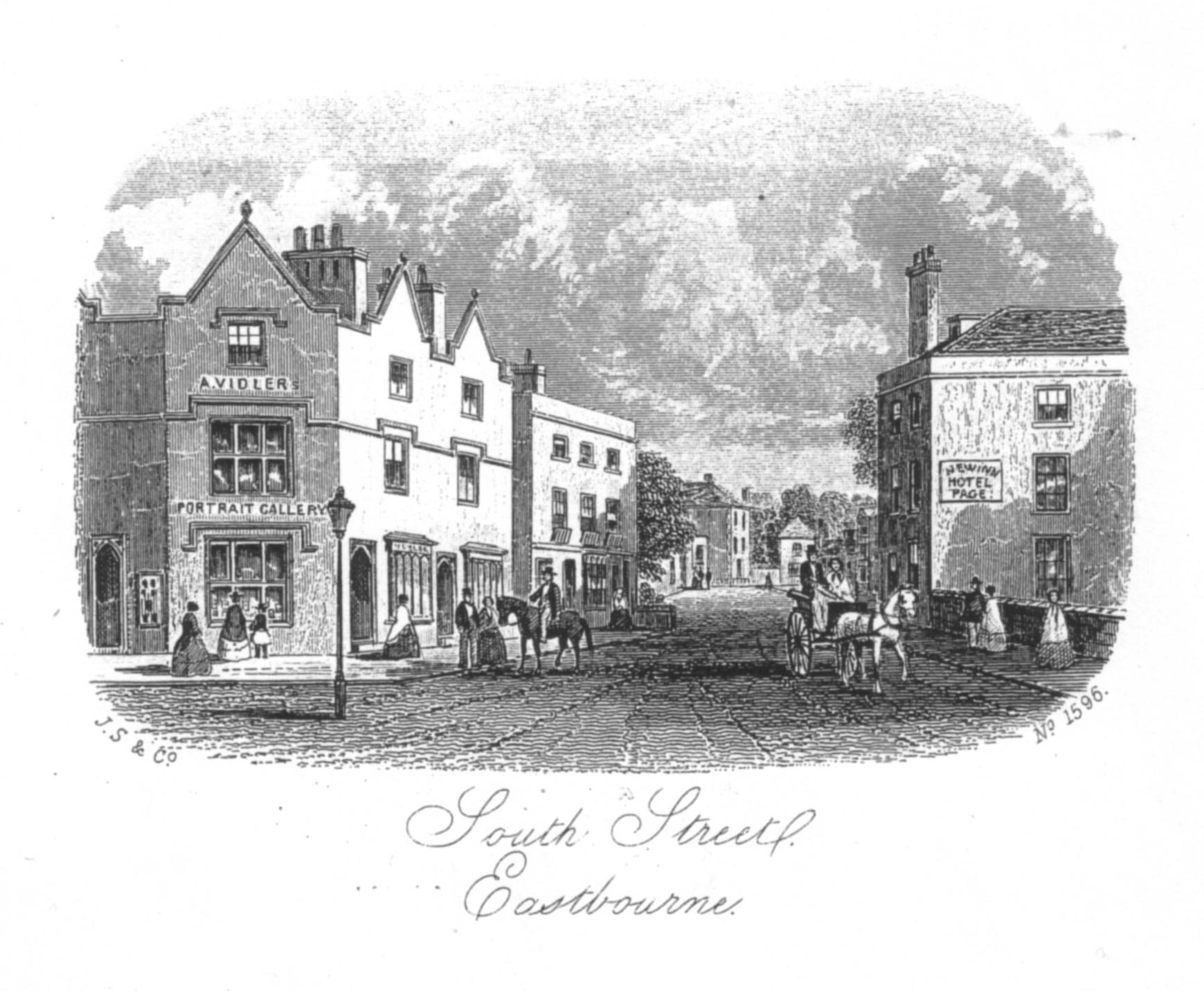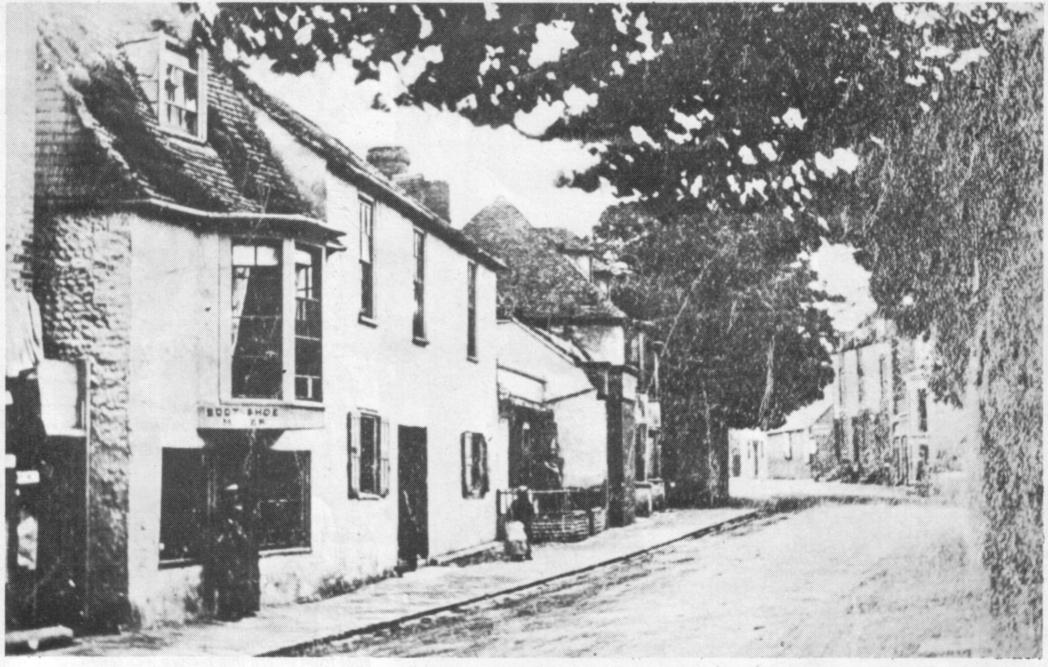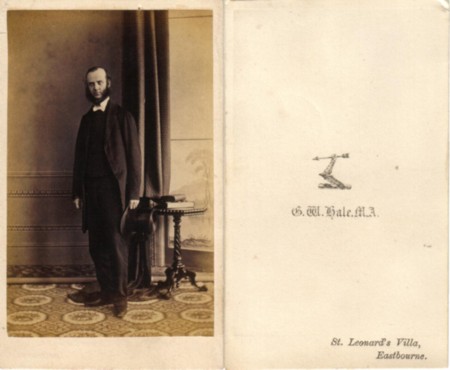
History of Photography in Eastbourne (Part 1)
Click here to Return to Home Page
Eastbourne

|
[ABOVE] Albert Vidler's Photographic Portrait Gallery on the corner of South Street, Eastbourne.(Woodcut engraving from a book of Eastbourne Views c1860). Vidler's Portrait Gallery, which opened around 1857, was Eastbourne's first permanent photographic portrait studio. [ Illustration courtesy of Ted Hide of Eastbourne ] |
A History of Professional Photography in Eastbourne : Part One 1857-1863
|
The Earliest Photographic Studio Professional photography arrived relatively late in Eastbourne. The earliest daguerreotype portrait studios had to be licensed by Richard Beard, who held the patent rights on the daguerreotype process in England. The first photographic portrait studio in Sussex was established at Brighton in 1841 by William Constable, who paid £1,000 for an exclusive daguerreotype licence. Another daguerreotype licence, which covered the city of Chichester and six towns in the surrounding area, was issued before 1847. In the eastern part of Sussex, Richard Beauford, who had invented his own "Daguerreotype Accelerator", was taking photographic portraits at St. Leonards-on-Sea in 1849 and opened a second studio in Hastings in 1850. Eastbourne had to wait until around 1858 before it had its own permanent, photographic portrait studio. Albert Vidler ( 1828-1894) set up a photographic portrait studio in Eastbourne around 1857. Vidler, an artist and surveyor, had acquired a corner shop at the western end of South Street, where he constructed a "Glass Room" for the purpose of taking photographic portraits. Albert Vidler commenced business at 86 South Street around the time of his marriage in July 1857. When his first child was baptised on 17th October 1858, Vidler gave his occupation as "Photographer" and when F. R. Melville's Directory & Gazetteer of Sussex was published in 1858 it featured an advertisement for "Albert Vidler, Photographic Artist, Stationer &c" at the "Corner of South Street, Eastbourne". Albert Vidler's advertisement of 1858 offered "Portraits, in Case, from 2s 6d, taken in a Glass Room constructed expressly for the purpose".
|
[ABOVE] Advertisement for Albert Vidler, Photographic Artist, of South Street, Eastbourne, which appeared in Melville's Directory of Sussex, published in 1858. Vidler appears to have been Eastbourne's first professional photographer with his own permanent studio. |
|
[ABOVE] A collodion positive portrait of a young man, believed to have been taken at Albert Vidler's Photographic Portrait Gallery in South Street, Eastbourne around 1860. A collodion positive or ambrotype was, in fact, a thin, bleached glass negative, which, when backed with black lacquer, dark brown varnish or black velvet, took on the appearance of a positive image. The collodion positive picture is on glass ( note the cracks in the glass to the right of the sitter's head ) and so, for both protection and presentation, it has been placed under a gilt mat and fixed inside a pinchbeck metal frame. The sitter was a member of the Coppard /Hart family who spent his whole life in Eastbourne. At the time this portrait was made, Albert Vidler was the only photographer in Eastbourne. [ Image, courtesy of Ted Hide of Eastbourne] |
Collodion Positive Portraits By 1858, daguerreotype portraits were obsolete and therefore, the cased portraits mentioned by Vidler were probably collodion positives ( known in America as ambrotypes ). While daguerreotypes were photographic images captured on silvered copper plates, collodion positives were photographs on glass. The "wet collodion" process had been introduced by Frederick Scott Archer in 1851 and involved coating a glass plate with a mixture of potassium iodide and a sticky substance called collodion. Archer's "wet collodion" process could produce high quality negatives after exposures of only a few seconds. Frederick Scott Archer's collodion 'wet plate' process produced a glass negative which could make an unlimited number of prints on paper. However, most customers were seeking a cheap alternative to the handsome daguerreotype portrait, which came protected under glass in a metal frame and presented in a velvet-lined, leather-bound display case. Scott Archer soon realised that by underexposing or "bleaching" the collodion glass negative and placing it on a black background ( black paper, very dark varnish or a black velvet cloth ) the image took on the appearance of a positive picture. The resulting image was as sharp and clear as a daguerreotype, yet Archer's new process was cheaper and less complicated. Furthermore, the collodion positive process was incredibly quick to perform. Photographers could see immediately the commercial possibilities of a cheap and speedy method of taking portraits. Protected by glass, placed in a metal frame and inserted in a presentation case or an elaborate frame, the collodion positive was an inexpensive substitute for the daguerreotype portrait.Frederick Scott Archer's collodion 'wet plate' process produced a glass negative which could make an unlimited number of prints on paper. However, most customers were seeking a cheap alternative to the handsome daguerreotype portrait, which came protected under glass in a metal frame and presented in a velvet-lined, leather-bound display case. Scott Archer soon realised that by underexposing or "bleaching" the collodion glass negative and placing it on a black background ( black paper, very dark varnish or a black velvet cloth ) the image took on the appearance of a positive picture. The resulting image was as sharp and clear as a daguerreotype, yet Archer's new process was cheaper and less complicated. Furthermore, the collodion positive process was incredibly quick to perform. Photographers could see immediately the commercial possibilities of a cheap and speedy method of taking portraits. Protected by glass, placed in a metal frame and inserted in a presentation case or an elaborate frame, the collodion positive was an inexpensive substitute for the daguerreotype portrait. |

| [ABOVE] A photograph of Lower South Street, Eastbourne taken in 1862. It is possible that this photograph was taken by Albert Vidler, who was in business as a photographer in Eastbourne from around 1857 to 1862 and had a photographic studio at the other end of South Street. |
Carte-de-Visite Portraits
| From 1858 to 1861,
Albert Vidler
had a virtual monopoly in the production of photographic portraits in
Eastbourne. In the 1861 Census, Albert Vidler was the only person residing in Eastbourne to give his
profession or occupation as "Photographer". However, by 1862, at least three rival
photographers were active in Eastbourne and all three were offering to take
carte-de-visite portraits, the new, popular format for portrait photography.
Cartes-de-visite were small photographic paper prints on card mounts the same
size as conventional visiting cards (roughly 21/2
inches by 41/4
inches or 6.3 cm by 10.5 cm).
This photograph format originated in France and so a small portrait mounted on
card came to be known
as a 'carte-de-visite', the
French term for visiting
card. George Robinson, Photographic Artist, "Late of San Francisco, California", was operating a photographic studio in Eastbourne at Cornfield Road early in 1862. While Vidler charged 2s 6d for a single portrait on glass, Robinson's prices started at one shilling for one portrait. For a single carte-de-visite (cdv) portrait, Robinson charged 2s 6d, but if customers ordered extra copies they only had to pay 10 shillings for ten cdvs. In April 1862, George Robinson advertised the removal of his Gallery to his home address at 6, Terminus Road. By August 1862, Robinson had increased the price of 10 cartes-de-visite to 10s 6d.
Mr Bennett did not have a permanent studio in Eastbourne, but made seasonal visits to the seaside resort with a mobile studio. During August and September 1862, Bennett's Photographic Carriage was stationed in Cornfield Road, Eastbourne, where a customer could purchase ten "Album Portraits" ( carte-de-visite size ) for 10s 6d. Bennett was back with his 'Photographic Carriage' for a "Second Season in Eastbourne" in August 1863, this time parking his mobile studio near Eastbourne's Railway Station. |
 [ABOVE] Part of an uncut sheet of carte-de-visite portraits (c1862). In 1854, a Parisian photographer named Andre Adolphe Disderi devised a multi-lens camera with a collodion plate that could be moved to capture between four and twelve small portraits on a single glass negative. A photographer equipped with a multi-lens camera could take a number of portraits, in a variety of poses, all on one camera plate. |
| George Hale (1832-1900)
was the proprietor of 'The Photographic Studio' at St Leonard's Villa, opposite Trinity
Church in Eastbourne and in August 1862 he announced that had "completed his
arrangements for taking the CARTE-DE-VISITE and the new VIGNETTE PORTRAITS."
( A vignette portrait was produced when the edges of a subject in a
photograph were deliberately blurred to give the appearance of a crayon drawing
). George Hale also offered special prices for multiple copies, twenty-one
cartes-de-visite for 21 shillings or fifty copies for 42 shillings.
[ABOVE] An advertisement for Hale's Photographic Studio at St. Leonard's Villa, opposite Trinity Church, Eastbourne, which appeared on the front page of The Eastbourne Gazette on Wednesday, 13th August, 1862. Albert Vidler must have found it difficult to withstand the sudden arrival of competitors. Vidler may not have had the expertise or the equipment and apparatus necessary to set up a successful carte-de-visite studio. Photographic businesses which produced carte-de-visite portraits employed specially designed multi-lens cameras which could capture between four and twelve small portraits on a single glass negative. New studio settings, which included furniture, drapes, fake classical columns, plinths and balustrades and painted backdrops, were also required by studios specialising in carte-de-visite portraits. Larger businesses could also employ experienced camera operators and photo-colouring artists from top London studios. Vidler probably found that his 'one-man' business and his now outdated equipment and methods could not compete with studios producing cartes-de-visite. ( Even though he was in business in 1862 when "cartomania" broke out, no carte-de-visite portrait by Albert Vidler has yet been discovered). On 9th August 1862, Vidler placed the following advertisement in the Sussex Express : " TO PHOTOGRAPHERS. TO BE DISPOSED OF, an old-established PHOTOGRAPHIC BUSINESS, with Glass Room and Apparatus complete. - For particulars apply to A. VIDLER, south street, Eastbourne."
|
 [ABOVE] Back and front of a carte-de-visite portrait of a man from the studio of George Willes Hale of St. Leonard's Villa, Eastbourne ( c1862 ). St Leonard's Villa was situated at the western end of Seaside Road, now re-named Trinity Trees. |
|
[ABOVE] Back and front of a carte-de-visite portrait from the studio of George Willes Hale of St. Leonard's Villa, Eastbourne ( c1862 ). |
||||||||||||||||||||||||
Photographers' Lives [ For biographies of these photographers, click on the name links ]
| Mr. BENNETT | |
| George Willes HALE | (born 1832, West Ashby, Lincs.- died 1900, Totnes, Devon ) |
| George ROBINSON | |
| Albert VIDLER | (born 1828 Hastings, Sussex - died 1894, Pevensey , Sussex ) |
|
INFORMATION REQUIRED |
| If you have any information on the above named photographers or examples of their work, please contact me by e-mail. Thanks, David Simkin. |
|
|
Click here to go to : A History of Professional Photography in Eastbourne : Part Two 1864-1870
Click here to go to Directory of Photographic Studios in Eastbourne, 1858-1910
Click here to Return to Home Page